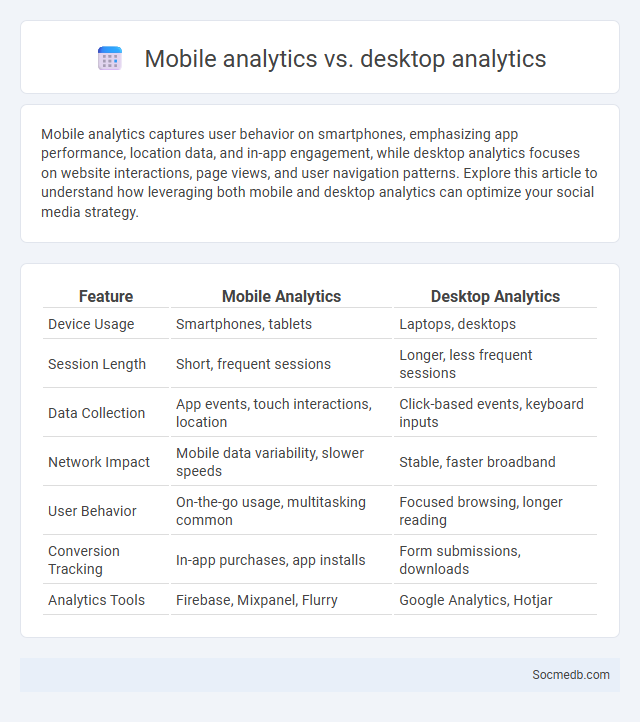
Photo illustration: Mobile analytics vs desktop analytics
Mobile analytics captures user behavior on smartphones, emphasizing app performance, location data, and in-app engagement, while desktop analytics focuses on website interactions, page views, and user navigation patterns. Explore this article to understand how leveraging both mobile and desktop analytics can optimize your social media strategy.
Table of Comparison
| Feature | Mobile Analytics | Desktop Analytics |
|---|---|---|
| Device Usage | Smartphones, tablets | Laptops, desktops |
| Session Length | Short, frequent sessions | Longer, less frequent sessions |
| Data Collection | App events, touch interactions, location | Click-based events, keyboard inputs |
| Network Impact | Mobile data variability, slower speeds | Stable, faster broadband |
| User Behavior | On-the-go usage, multitasking common | Focused browsing, longer reading |
| Conversion Tracking | In-app purchases, app installs | Form submissions, downloads |
| Analytics Tools | Firebase, Mixpanel, Flurry | Google Analytics, Hotjar |
Introduction to Digital Analytics Platforms
Digital analytics platforms collect and analyze data from social media channels to provide insights into user behavior, engagement, and campaign performance. Key tools such as Google Analytics, Adobe Analytics, and Hootsuite enable marketers to track metrics like click-through rates, conversion rates, and audience demographics in real time. These platforms support data-driven decision-making, helping businesses optimize content strategies and improve ROI on social media investments.
Defining Mobile Analytics
Mobile analytics involves collecting and analyzing data from users interacting with mobile applications and devices to understand behavior, engagement, and performance. It tracks metrics such as session duration, user retention, in-app purchases, and conversion rates to optimize app experience and marketing strategies. By leveraging mobile analytics, you gain actionable insights to enhance customer engagement and drive targeted growth in your social media campaigns.
Understanding Desktop Analytics
Desktop analytics provide detailed insights into user behavior, device usage, and engagement patterns on social media platforms. By analyzing click paths, session durations, and interaction rates, you can optimize content strategies and enhance user experience. Leveraging this data allows your brand to tailor campaigns for increased reach and higher conversion rates.
Key Metrics: Mobile vs Desktop
Mobile devices account for over 54% of social media traffic, emphasizing the importance of optimizing content for smaller screens and touch navigation. Desktop users, typically generating longer engagement sessions, offer opportunities for deeper interaction and detailed analytics tracking. Understanding the distinct behaviors between mobile and desktop platforms helps you tailor campaigns and improve ROI by leveraging key metrics such as session duration, click-through rates, and conversion paths.
User Behavior Differences Across Devices
User behavior on social media platforms varies significantly between mobile devices and desktop computers, with mobile users favoring quick, frequent interactions such as scrolling and liking posts, while desktop users engage in longer sessions involving content creation and detailed browsing. Mobile users exhibit higher engagement rates with short-form videos and stories, driven by the convenience of on-the-go access, whereas desktop users tend to prefer comprehensive content consumption and in-depth comments. These behavioral differences influence platform algorithms and targeted advertising strategies, optimizing user experience based on device-specific interaction patterns.
Reporting: Transforming Analytics into Insights
Social media reporting transforms raw analytics into actionable insights by highlighting key performance indicators such as engagement rates, impressions, and audience demographics. You can leverage these data-driven insights to refine content strategies, optimize posting schedules, and enhance overall brand visibility. Effective reporting tools provide real-time dashboards and comprehensive reports, enabling continuous monitoring and strategic decision-making.
Tools for Mobile and Desktop Analytics
Social media tools for mobile and desktop analytics provide valuable insights into user engagement, follower growth, and content performance across platforms such as Facebook, Instagram, and Twitter. These tools utilize real-time data tracking, sentiment analysis, and demographic breakdowns to help you optimize your social media strategy and improve ROI. Popular solutions like Hootsuite, Sprout Social, and Google Analytics offer seamless integration and customizable dashboards tailored to mobile and desktop environments.
Challenges in Cross-Device Tracking
Cross-device tracking faces significant challenges due to privacy regulations like GDPR and CCPA restricting data collection and user consent. Variations in device usage, operating systems, and browser settings create fragmentation, complicating accurate user identification. Your ability to deliver cohesive marketing strategies depends on overcoming these obstacles through advanced algorithms and deterministic data sources.
Best Practices for Data Reporting
Accurate data reporting on social media platforms enhances your ability to track campaign performance and audience engagement effectively. Utilize real-time analytics tools, focus on key metrics such as reach, impressions, and conversion rates, and ensure data consistency across reporting periods. By implementing these best practices, your social media strategy will be data-driven and optimized for better decision-making.
Choosing the Right Analytics Approach
Selecting the appropriate social media analytics approach involves identifying key performance indicators (KPIs) aligned with specific business goals, such as engagement rates, click-through rates, and conversion metrics. Utilizing advanced tools like Google Analytics, Hootsuite Insights, or Sprout Social enables detailed tracking and analysis of audience behavior and content effectiveness. Data-driven decisions made through these tailored analytics methods enhance campaign optimization and drive measurable growth in social media presence.
 socmedb.com
socmedb.com